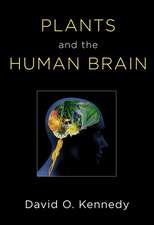Chemosensory Information Processing: Nato ASI Subseries H:, cartea 39
Editat de Detlev Schilden Limba Engleză Paperback – 23 dec 2011
Din seria Nato ASI Subseries H:
- 18%
 Preț: 953.82 lei
Preț: 953.82 lei -
 Preț: 393.13 lei
Preț: 393.13 lei - 15%
 Preț: 643.34 lei
Preț: 643.34 lei - 15%
 Preț: 643.34 lei
Preț: 643.34 lei - 15%
 Preț: 641.03 lei
Preț: 641.03 lei - 15%
 Preț: 642.83 lei
Preț: 642.83 lei - 15%
 Preț: 642.51 lei
Preț: 642.51 lei - 5%
 Preț: 712.81 lei
Preț: 712.81 lei -
 Preț: 392.97 lei
Preț: 392.97 lei - 15%
 Preț: 651.02 lei
Preț: 651.02 lei - 15%
 Preț: 640.24 lei
Preț: 640.24 lei - 18%
 Preț: 948.61 lei
Preț: 948.61 lei - 15%
 Preț: 655.92 lei
Preț: 655.92 lei - 15%
 Preț: 655.92 lei
Preț: 655.92 lei - 15%
 Preț: 653.14 lei
Preț: 653.14 lei - 15%
 Preț: 650.19 lei
Preț: 650.19 lei - 15%
 Preț: 655.13 lei
Preț: 655.13 lei - 15%
 Preț: 652.17 lei
Preț: 652.17 lei - 15%
 Preț: 675.58 lei
Preț: 675.58 lei - 18%
 Preț: 958.07 lei
Preț: 958.07 lei - 18%
 Preț: 961.41 lei
Preț: 961.41 lei - 18%
 Preț: 970.56 lei
Preț: 970.56 lei - 5%
 Preț: 1100.30 lei
Preț: 1100.30 lei - 5%
 Preț: 376.43 lei
Preț: 376.43 lei - 15%
 Preț: 650.86 lei
Preț: 650.86 lei - 15%
 Preț: 644.63 lei
Preț: 644.63 lei - 15%
 Preț: 655.60 lei
Preț: 655.60 lei - 18%
 Preț: 963.47 lei
Preț: 963.47 lei - 15%
 Preț: 648.42 lei
Preț: 648.42 lei - 5%
 Preț: 731.43 lei
Preț: 731.43 lei - 15%
 Preț: 653.14 lei
Preț: 653.14 lei - 18%
 Preț: 960.13 lei
Preț: 960.13 lei - 18%
 Preț: 968.34 lei
Preț: 968.34 lei - 18%
 Preț: 953.97 lei
Preț: 953.97 lei - 15%
 Preț: 654.95 lei
Preț: 654.95 lei - 15%
 Preț: 652.49 lei
Preț: 652.49 lei - 15%
 Preț: 650.86 lei
Preț: 650.86 lei - 5%
 Preț: 367.64 lei
Preț: 367.64 lei - 5%
 Preț: 1104.68 lei
Preț: 1104.68 lei - 15%
 Preț: 651.99 lei
Preț: 651.99 lei - 15%
 Preț: 647.27 lei
Preț: 647.27 lei - 15%
 Preț: 653.00 lei
Preț: 653.00 lei - 15%
 Preț: 656.25 lei
Preț: 656.25 lei - 18%
 Preț: 962.35 lei
Preț: 962.35 lei - 15%
 Preț: 644.82 lei
Preț: 644.82 lei - 15%
 Preț: 666.55 lei
Preț: 666.55 lei - 15%
 Preț: 642.68 lei
Preț: 642.68 lei - 15%
 Preț: 645.96 lei
Preț: 645.96 lei - 15%
 Preț: 651.84 lei
Preț: 651.84 lei
Preț: 953.20 lei
Preț vechi: 1162.43 lei
-18% Nou
Puncte Express: 1430
Preț estimativ în valută:
182.40€ • 190.92$ • 151.81£
182.40€ • 190.92$ • 151.81£
Carte tipărită la comandă
Livrare economică 31 martie-14 aprilie
Preluare comenzi: 021 569.72.76
Specificații
ISBN-13: 9783642751295
ISBN-10: 3642751296
Pagini: 420
Ilustrații: VIII, 403 p.
Dimensiuni: 170 x 242 x 22 mm
Greutate: 0.67 kg
Ediția:Softcover reprint of the original 1st ed. 1990
Editura: Springer Berlin, Heidelberg
Colecția Springer
Seria Nato ASI Subseries H:
Locul publicării:Berlin, Heidelberg, Germany
ISBN-10: 3642751296
Pagini: 420
Ilustrații: VIII, 403 p.
Dimensiuni: 170 x 242 x 22 mm
Greutate: 0.67 kg
Ediția:Softcover reprint of the original 1st ed. 1990
Editura: Springer Berlin, Heidelberg
Colecția Springer
Seria Nato ASI Subseries H:
Locul publicării:Berlin, Heidelberg, Germany
Public țintă
ResearchCuprins
1. Response of olfactory receptor cells, isolated and in situ, to low concentrations of odorants.- 2. Excitation and adaptation of frog olfactory receptor neurones upon stimulation with second messengers and natural odorants.- 3. Receptor selectivity and dimensionality of odours at the stage of the olfactory receptor cells.- 4. The biochemistry of odorant reception and transduction.- 5. Molecular elements of olfactory signal transduction in insect antennae.- 6. The Xenopus oocyte as an in vitro translation and expression system for chemosensory — specific gene products.- 7. Stimulus properties and binding to receptors.- 8. Principles and properties of some solid state chemical sensors.- 9. Purification of an odorant binding protein from human nasal mucosa.- 10. The design of an artificial olfactory system.- 11. Morphological basis of information processing in the olfactory bulb.- 12. Olfactory bulb plasticity.- 13. Olfactory bulb and antennal lobe.- 14. Processing of pheromone information from receptor cells to antennal lobe neurons in heliothis moths.- 15. Single cell activities and the olfactory code.- 16. Is the olfactory bulb functionally organized in parallel columns ?.- 17. Perceptual performance in peripherally reduced olfactory systems.- 18. Scent trailing by tracking dogs. What is the physiological basis for concentration coding ?.- 19. Extracting information from spike trains of olfactory bulb neurons.- 20. Optical recording of neuronal activity: parallel versus serial methods.- 21. Temporal patterns of membrane potential in the olfactory bulb observed with intracellular recording and voltage-sensitive dye imaging: early hyperpolarization..- 22. Optical mapping of the olfactory system activity using voltage-sensitive dyes.- 23. Animated pseudocolor activitymaps (PAM’s): scientific visualization of brain electrical activity.- 24. Chemosensors with pattern recognition.- 25. Monte Carlo generation of chemosensory maps in the olfactory bulb: glomerular activity patterns.- 26. Olfactory EEG changes under serial discrimination of odorants by rabbits.














